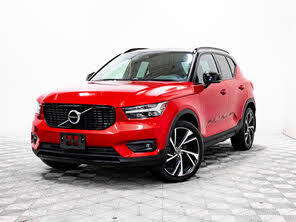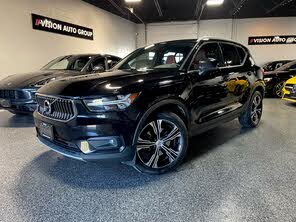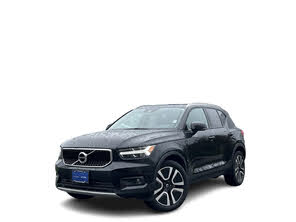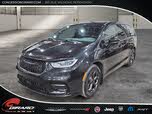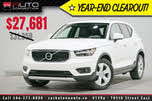2022 Chrysler Pacifica Hybrid vs 2021 Volvo XC40
Overview | |
MSRP$33,700 | MSRP$49,000 |
Listings43 | Listings40 |
Ratings & Reviews | |
User Reviews | User Reviews |
Expert reviews8.0 out of 10 | Expert reviews7.5 out of 10 |
Pros
Cons
| |
2021 Volvo XC40 Reviews SummaryIntroduced for the 2019 model year, the Volvo XC40 enters 2021 with one major change—the addition of an all-electric powertrain option. The 2021 Volvo XC40 Recharge is the Scandinavian automaker’s first mass-market pure electric vehicle, in fact. The Recharge will be sold alongside gasoline versions of the XC40, which carry over largely unchanged, and compete against small luxury crossovers like the Audi Q3, BMW X1, Mercedes-Benz GLA-Class, and Lexus UX. With its electric powertrain, the Recharge is a de facto Tesla Model Y competitor. It’s also priced similar to high-end versions of the Ford Mustang Mach-E, although the two electric crossovers have somewhat different philosophies. In addition to that zero-emission powertrain, the Recharge gets an Android-based operating system, over-the-air (OTA) software update capability for all vehicle systems, and some updates to driver-assist tech. These changes don’t apply to gasoline 2021 XC40 models, but Volvo does plan to add the Android operating system to more vehicles in the future. Since the Recharge is the main new thing for the 2021 XC40, that’s what we focused on for this review. While the gasoline XC40 is available in three trim levels—Momentum, R-Design, and Inscription—with standard all-wheel drive (AWD) in Canada, the Recharge is only offered in a single trim level. | |
2022 Chrysler Pacifica Hybrid Reviews SummaryThe summer of 2022 has been a doozy. Gas prices went sky high and heat waves rolled across the country. If you’re rethinking the purchase of a three-row SUV and trying to find a fuel-efficient solution that emits greenhouse gas emissions only part of the time, the seven-passenger Chrysler Pacifica Hybrid might be a good solution. It doesn’t offer all-wheel drive (AWD) as other Pacificas do, but it has a plug-in hybrid powertrain supplying a Natural Resources Canada-rated 51 kilometres of electric range before the gasoline V6 engine fires up to deliver 8.0 litres per 100 kilometres in combined driving. | |
No video found | No video found |
Popular Features & Specs | |
Engine2.0L 187 hp I4 | Engine3.6L 260 hp V6 Hybrid |
Drive TrainFWD | Drive TrainFWD |
Seating Capacity5 | Seating Capacity7 |
Horsepower187 hp @ 4700 rpm | Horsepower |
EV Battery Capacity | EV Battery Capacity16 kWh |
MPG City23 | MPG City87 |
MPG Highway32 | MPG Highway77 |
Battery Charge Time (120V) | Battery Charge Time (120V)14 hours |
Battery Charge Time (240V) | Battery Charge Time (240V)2 hours |
Engine | |
Engine Name2.0L 187 hp I4 | Engine Name3.6L 260 hp V6 Hybrid |
Torque221 lb-ft @ 1400 rpm | Torque |
Horsepower187 hp @ 4700 rpm | Horsepower |
Battery Charge Time (120V) | Battery Charge Time (120V)14 hours |
Battery Charge Time (240V) | Battery Charge Time (240V)2 hours |
DrivetrainFWD | DrivetrainFWD |
Fuel Economy | |
EV Battery Capacity | EV Battery Capacity16 kWh |
MPG City23 | MPG City87 |
MPG Highway32 | MPG Highway77 |
Interior | |
Leather SeatsStandard | Leather Seats |
Seating Capacity5 | Seating Capacity7 |
Safety | |
Front Crash Overall5 | Front Crash Overall4 |
Side Crash Overall5 | Side Crash Overall5 |
Dimensions & Capacity | |
Cargo Space20.7 cu ft | Cargo Space32.3 cu ft |
Curb Weight3627 lbs | Curb Weight5010 lbs |
Height65.3 in | Height69.9 in |
Length174.2 in | Length204.3 in |
Width80.1 in | Width90.4 in |
Wheelbase106.4 in | Wheelbase121.6 in |
Maximum Payload1133 lbs | Maximum Payload1313 lbs |
Number of doors4 | Number of doors4 |
Maximum Towing Capacity3500 lbs | Maximum Towing Capacity |
Overview | ||
MSRP | $33,700 | $49,000 |
Listings | ||
Ratings & Reviews | ||
User reviews | ||
Expert reviews | 8.0 out of 10Read full review | 7.5 out of 10Read full review |
Pros & cons | Pros
Cons
| |
Summary | Introduced for the 2019 model year, the Volvo XC40 enters 2021 with one major change—the addition of an all-electric powertrain option. The 2021 Volvo XC40 Recharge is the Scandinavian automaker’s first mass-market pure electric vehicle, in fact. The Recharge will be sold alongside gasoline versions of the XC40, which carry over largely unchanged, and compete against small luxury crossovers like the Audi Q3, BMW X1, Mercedes-Benz GLA-Class, and Lexus UX. With its electric powertrain, the Recharge is a de facto Tesla Model Y competitor. It’s also priced similar to high-end versions of the Ford Mustang Mach-E, although the two electric crossovers have somewhat different philosophies. In addition to that zero-emission powertrain, the Recharge gets an Android-based operating system, over-the-air (OTA) software update capability for all vehicle systems, and some updates to driver-assist tech. These changes don’t apply to gasoline 2021 XC40 models, but Volvo does plan to add the Android operating system to more vehicles in the future. Since the Recharge is the main new thing for the 2021 XC40, that’s what we focused on for this review. While the gasoline XC40 is available in three trim levels—Momentum, R-Design, and Inscription—with standard all-wheel drive (AWD) in Canada, the Recharge is only offered in a single trim level. | The summer of 2022 has been a doozy. Gas prices went sky high and heat waves rolled across the country. If you’re rethinking the purchase of a three-row SUV and trying to find a fuel-efficient solution that emits greenhouse gas emissions only part of the time, the seven-passenger Chrysler Pacifica Hybrid might be a good solution. It doesn’t offer all-wheel drive (AWD) as other Pacificas do, but it has a plug-in hybrid powertrain supplying a Natural Resources Canada-rated 51 kilometres of electric range before the gasoline V6 engine fires up to deliver 8.0 litres per 100 kilometres in combined driving. |
Video | No video found | No video found |
Popular Features & Specs | ||
Engine | 2.0L 187 hp I4 | 3.6L 260 hp V6 Hybrid |
Drive Train | FWD | FWD |
Seating Capacity | 5 | 7 |
Horsepower | 187 hp @ 4700 rpm | |
EV Battery Capacity | 16 kWh | |
MPG City | 23 | 87 |
MPG Highway | 32 | 77 |
Battery Charge Time (120V) | 14 hours | |
Battery Charge Time (240V) | 2 hours | |
Engine | ||
Engine Name | 2.0L 187 hp I4 | 3.6L 260 hp V6 Hybrid |
Torque | 221 lb-ft @ 1400 rpm | |
Horsepower | 187 hp @ 4700 rpm | |
Battery Charge Time (120V) | 14 hours | |
Battery Charge Time (240V) | 2 hours | |
Drivetrain | FWD | FWD |
Fuel Economy | ||
EV Battery Capacity | 16 kWh | |
MPG City | 23 | 87 |
MPG Highway | 32 | 77 |
Interior | ||
Leather Seats | Standard | |
Seating Capacity | 5 | 7 |
Safety | ||
Front Crash Overall | 5 | 4 |
Side Crash Overall | 5 | 5 |
Dimensions & Capacity | ||
Cargo Space | 20.7 cu ft | 32.3 cu ft |
Curb Weight | 3627 lbs | 5010 lbs |
Height | 65.3 in | 69.9 in |
Length | 174.2 in | 204.3 in |
Width | 80.1 in | 90.4 in |
Wheelbase | 106.4 in | 121.6 in |
Maximum Payload | 1133 lbs | 1313 lbs |
Number of doors | 4 | 4 |
Maximum Towing Capacity | 3500 lbs | |
The 2021 Volvo XC40 presented a more traditional SUV aesthetic compared to other small luxury crossovers, featuring a tall, flat roof and an upright rear hatch. It seamlessly integrated into the Volvo family with design elements like the “Thor’s Hammer” LED headlights and a simple oval grille. Gasoline models offered a retro touch with a white contrasting roof. The XC40 Recharge differentiated itself with a blanked-off grille, subtle “Recharge” badging, and unique alloy wheels. It also featured a gloss black roof and mirror caps, a distinct rear bumper, and a model-exclusive Sage Green Metallic colour. The interior was minimalist yet premium, with real metal trim and a combination of Nappa leather and Nubuck textile upholstery, creating a cohesive and upscale environment.
The 2022 Chrysler Pacifica Hybrid, while a minivan, offered a unique proposition with its plug-in hybrid drivetrain. Despite its minivan image, it provided practical features like sliding side doors, making it convenient for families. The Pacifica Hybrid was not particularly stylish, even with the S Appearance Package, and came with a hefty price tag. However, it offered a comfortable interior with black Nappa premium leather and a rounded design that some might find dated. The Pacifica Hybrid was a rare find as a plug-in hybrid minivan, offering a unique blend of utility and efficiency, albeit with a less exciting driving experience.


















The 2021 Volvo XC40 offered a three-tiered powertrain lineup, with the electric Recharge model at the top. The gasoline options included a 2.0-litre turbocharged four-cylinder engine with an eight-speed automatic transmission. The base T4 produced 187 horsepower and 221 pound-feet of torque, while the T5 delivered 248 hp and 258 lb-ft. The Recharge model shared its powertrain with the Polestar 2, featuring dual electric motors for all-wheel drive, producing a combined 402 hp and 486 lb-ft. It had a 78-kilowatt-hour battery pack, with 75 kWh usable, and could accelerate from zero to 100 km/h in 4.9 seconds. The XC40 emphasized luxury and comfort, with excellent ride quality and the capability for one-pedal driving. It also had a towing capacity of 900 kilograms.
The 2022 Chrysler Pacifica Hybrid combined a 3.6-litre V6 engine with a dual-motor electric drive system, producing a total of 260 horsepower. The 16-kWh battery pack allowed for an electric-only range of 51 kilometres, making it ideal for short commutes and errands. The Pacifica Hybrid could be charged using a standard household outlet, and its regenerative braking system helped extend the electric range. It offered an average fuel economy of 6.3 litres per 100 kilometres. While the Pacifica Hybrid's powertrain was impressive, the driving experience was less engaging, with light steering and unremarkable regenerative brakes. However, it excelled in efficiency and practicality for family use.
The 2021 Volvo XC40 offered no difference in passenger or cargo space between the Recharge and gasoline models. However, it was not particularly spacious, with less legroom and headroom compared to competitors like the Tesla Model Y and Ford Mustang Mach-E. The cargo area was also smaller, and the frunk was limited in size. Despite this, Volvo provided clever storage solutions, such as a removable trash bin in the centre console and large door bins. The Harman Kardon audio system's speakers were moved to the dashboard, allowing for extra storage space in the doors.
The 2022 Chrysler Pacifica Hybrid excelled in comfort and utility, offering three comfortable rows of seats and ample cargo space. It featured triple-zone automatic climate control, quality leather upholstery, and heated and ventilated front seats. Storage options were abundant, with extra shelves in the front door panels and a large floor tray under the centre console. The second-row seats were more comfortable than the standard Pacifica's Stow n’ Go seats, although they did not collapse into the floor. The third-row seat was reasonably comfortable, and the Pacifica Hybrid provided 914 litres of cargo space behind it. With the third-row seats folded, the cargo area expanded to 2,477 litres, and removing the second-row seats increased it to 3,978 litres.
The 2021 Volvo XC40 Recharge featured the Android Automotive OS infotainment system, offering Google apps like Google Assistant and Google Maps. It included a 9-inch touchscreen and a 12.3-inch digital instrument cluster, with top-notch graphics and menu layouts. The system supported Apple CarPlay, Android Auto, and SiriusXM satellite radio. The Recharge model also had OTA update capability, allowing for software updates without visiting a dealership. It lacked a start button, with the car starting automatically when the driver entered with the key fob.
The 2022 Chrysler Pacifica Hybrid came with the Uconnect 5 infotainment system, featuring a 10.1-inch touchscreen display with appealing graphics and a simple user interface. It supported wireless Apple CarPlay and Android Auto, SiriusXM satellite radio, and simultaneous Bluetooth pairing for two devices. The FamCam overhead camera system allowed parents to monitor rear-seat passengers. The system's voice recognition technology was hit-and-miss, but the available 20-speaker Harman Kardon sound system provided good audio quality. The Pacifica Hybrid also offered Amazon Fire TV for the rear-seat entertainment system, allowing passengers to stream content or download Amazon Prime Video.
The 2021 Volvo XC40 received the highest “Top Safety Pick+” rating from the IIHS and a five-star overall crash-test rating from the NHTSA. It came with a comprehensive list of standard safety features, including lane-keep assist, blind-spot monitoring, automatic emergency braking, and rear parking sensors. The Recharge model featured Volvo’s latest sensor suite, allowing for future advancements in driver aids.
The 2022 Chrysler Pacifica Hybrid claimed to offer more standard safety and security features than any other vehicle in the industry. It included a rear-seat reminder system and a complete package of standard driver-assist and collision-avoidance features. However, it lacked adaptive cruise control paired with lane-centring assist. The Pacifica earned a Top Safety Pick+ rating from the IIHS and a five-star overall safety rating from the NHTSA, with a four-star rating for frontal-impact protection.
CarGurus highlights

According to CarGurus experts, the overall rating for the 2021 Volvo XC40 is 8.0 out of 10, while the 2022 Chrysler Pacifica Hybrid scores 7.5 out of 10. Based on these ratings, the 2021 Volvo XC40 is the recommended choice for those seeking a luxury SUV with a strong emphasis on safety, design, and driving experience.
Choose the 2022 Chrysler Pacifica Hybrid if:
- You need a spacious and practical vehicle for transporting a family and cargo efficiently.
- You value the convenience of a plug-in hybrid drivetrain with electric-only driving capability.
- You require a vehicle with a comprehensive suite of safety features and family-friendly technology.
Choose the 2021 Volvo XC40 if:
- You prioritize a traditional luxury SUV design with premium interior materials.
- You seek a vehicle with a strong emphasis on safety and advanced driver-assistance features.
- You prefer a vehicle with a more engaging driving experience and excellent ride quality.
CarGurus highlights

According to CarGurus experts, the overall rating for the 2021 Volvo XC40 is 8.0 out of 10, while the 2022 Chrysler Pacifica Hybrid scores 7.5 out of 10. Based on these ratings, the 2021 Volvo XC40 is the recommended choice for those seeking a luxury SUV with a strong emphasis on safety, design, and driving experience.
Choose the 2022 Chrysler Pacifica Hybrid if:
Shop Now- You need a spacious and practical vehicle for transporting a family and cargo efficiently.
- You value the convenience of a plug-in hybrid drivetrain with electric-only driving capability.
- You require a vehicle with a comprehensive suite of safety features and family-friendly technology.
Choose the 2021 Volvo XC40 if:
Shop Now- You prioritize a traditional luxury SUV design with premium interior materials.
- You seek a vehicle with a strong emphasis on safety and advanced driver-assistance features.
- You prefer a vehicle with a more engaging driving experience and excellent ride quality.

By: CarGurus + AI
At CarGurus, our team of experienced automotive writers remain at the heart of our content operation, conducting hands-on car tests and writing insightful guides that are backed by years of industry experience. To complement this, we are harnessing AI to make our content offering more diverse and more helpful to shoppers than ever. To achieve this, our AI systems are based exclusively on CarGurus content, ratings and data, so that what we produce is both unique to CarGurus, and uniquely helpful to car shoppers.
















